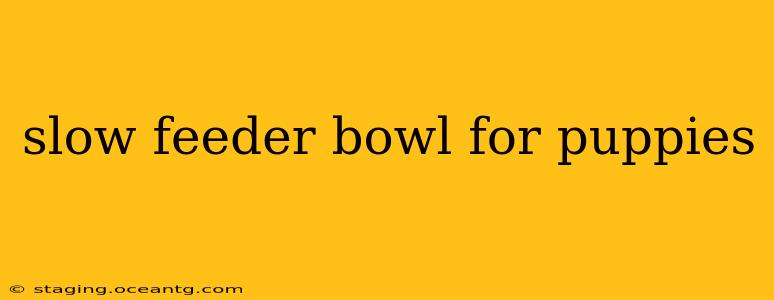Choosing the right food bowl for your puppy is crucial for their overall health and well-being. A slow feeder bowl can be a game-changer, particularly for puppies prone to gulping their food, which can lead to various health issues. This comprehensive guide delves into the benefits of slow feeder bowls for puppies, addresses common concerns, and helps you choose the perfect one for your furry friend.
Why Use a Slow Feeder Bowl for Puppies?
Puppies, with their boundless energy and enthusiasm, often tend to inhale their food. This rapid eating can lead to several problems:
- Bloat (Gastric Dilatation-Volvulus): This is a life-threatening condition where the stomach twists, cutting off blood supply. Gulping food significantly increases the risk, especially in deep-chested breeds.
- Vomiting: Eating too quickly can cause discomfort and lead to vomiting, potentially resulting in messy cleanups and nutritional loss.
- Choking: Inhaling food whole can lead to choking hazards, particularly with smaller kibble sizes.
- Poor Digestion: Rapid eating prevents proper chewing, hindering the digestive process and potentially leading to digestive upset.
A slow feeder bowl mitigates these risks by forcing your puppy to eat more slowly and deliberately. This encourages better digestion, reduces stress on their digestive system, and promotes a more relaxed mealtime.
What are the Different Types of Slow Feeder Bowls for Puppies?
The market offers a wide variety of slow feeder bowls designed to cater to different needs and preferences. Here are some popular types:
- Puzzle Bowls: These bowls incorporate obstacles and mazes that make your puppy work for their food. They are excellent for mental stimulation and can be particularly engaging for food-motivated pups.
- Labyrinth Bowls: Similar to puzzle bowls, labyrinth bowls feature intricate pathways that slow down eating.
- Raised Bowls: While not strictly slow feeders, raised bowls improve posture during eating and can be helpful for puppies with joint issues. Combining a raised bowl with a slow-feeder insert can provide additional benefits.
- Mats: Slow-feeder mats are flat surfaces with raised obstacles. They offer a less contained feeding experience compared to bowls.
Choosing the right type depends on your puppy's age, breed, and personality. Consider starting with a simpler design and gradually increasing the complexity as your puppy gets accustomed to the slow-feeding process.
How to Introduce a Slow Feeder Bowl to Your Puppy?
Introducing a new bowl shouldn't be abrupt. Follow these steps for a smooth transition:
- Introduce it gradually: Start by placing a small amount of food in the slow feeder bowl and allowing your puppy to explore it.
- Positive reinforcement: Reward your puppy's efforts with praise and treats.
- Monitor their eating: Supervise your puppy's first few meals with the slow feeder bowl to ensure they aren't struggling.
- Adjust feeding times: Be prepared to adjust feeding times as slow feeding might take longer.
- Cleanliness: Slow feeder bowls can be more challenging to clean; ensure you choose a design that's easy to maintain.
What Size Slow Feeder Bowl Should I Choose for My Puppy?
The size of the slow feeder bowl should be appropriate for your puppy's size and the amount of food they consume at each meal. A bowl that's too small may be frustrating, while a bowl that's too large might not be effective in slowing down eating. Always check the manufacturer's recommendations regarding size and suitability for different breeds and ages.
Are Slow Feeder Bowls Suitable for All Puppies?
While slow feeder bowls offer many benefits, they might not be suitable for all puppies. Puppies with specific medical conditions or those exhibiting signs of food aggression should be assessed by a veterinarian before using a slow feeder bowl. In addition, some puppies may initially find it frustrating, so patience and positive reinforcement are key.
How Often Should I Clean My Puppy's Slow Feeder Bowl?
Regular cleaning is essential to maintain hygiene and prevent bacterial growth. Wash the slow feeder bowl daily with warm soapy water and ensure it's thoroughly rinsed and dried before each use. You can also use a dishwasher-safe bowl for easy cleaning.
Can Slow Feeder Bowls Help with Picky Eaters?
While primarily designed to slow down eating, some slow feeder bowls can help with picky eaters. The puzzle-solving aspect can make mealtimes more stimulating and engaging, potentially encouraging a less enthusiastic eater to finish their food.
This guide provides a comprehensive overview of slow feeder bowls for puppies. Remember to choose a bowl that suits your puppy's needs and always supervise their mealtimes, especially during the initial transition phase. A slow feeder bowl is an excellent investment in your puppy's long-term health and happiness.
